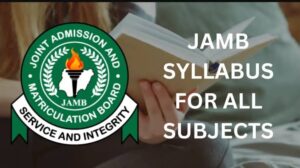Jamb Syllabus for Physics: Alright, let’s break down the JAMB Physics syllabus together. Think of this syllabus as your personal roadmap for the exam. It’s not meant to scare you; instead, it’s your best friend because it tells you exactly what you need to study. No more guessing games! The main goal of this syllabus is to help you understand the basic principles of physics, develop a scientific way of thinking, and apply these concepts to solve real-world problems .
Jamb Syllabus for Physics
Now, let’s dive into the key topics you’ll need to focus on. I’ll group them into broader themes to make it easier to digest.
💡 Mechanics: The Foundation of Physics
This is a huge part of the syllabus and covers how objects move and interact. It includes:
· Measurements and Units: You’ll learn about tools like vernier calipers and screw gauges, and concepts like significant figures and standard form. The idea is to understand how to measure things accurately and express those measurements properly .
· Motion: This isn’t just about things moving in straight lines. You’ll study projectiles (like a ball thrown into the air), circular motion, and Simple Harmonic Motion (like a pendulum swinging). You’ll also get into Newton’s laws of motion, which explain how forces affect movement, and concepts like momentum and impulse .
· Forces and Equilibrium: This is about balance. You’ll learn about different types of forces, how to calculate the resultant of multiple forces, and the conditions needed for an object to be stable or unstable. Lami’s theorem and principles of moments are key here .
· Gravitational Field: This section covers Newton’s law of universal gravitation, how gravity varies on Earth, and concepts like escape velocity and weightlessness .
· Friction: You’ll explore the differences between static and dynamic friction, how to reduce friction, and its advantages and disadvantages in daily life .
· Work, Energy, and Power: This ties into mechanics closely. You’ll learn the definitions of work, energy, and power, different forms of energy, and the principle of conservation of energy. You’ll also interpret graphs, like the area under a force-distance curve .
🔥 Energy and Its Applications
This theme is about where energy comes from and how it’s used:
· Sources of Energy: You’ll study renewable and non-renewable energy sources, their environmental impacts (like global warming), and how energy is converted from one form to another .
· Simple Machines: This includes devices like levers and pulleys, and you’ll learn how to calculate mechanical advantage, velocity ratio, and efficiency .
📏 Properties of Matter
This deals with how materials behave under different conditions:
· Elasticity: You’ll study Hooke’s law, Young’s modulus, and how to interpret force-extension graphs. Springs and elastic strings are key here .
· Pressure: This covers atmospheric pressure, how it’s measured with barometers, and pressure in fluids. Pascal’s principle and Archimedes’ principle are important concepts .
· Liquids at Rest: You’ll learn about density, relative density, upthrust, and flotation principles .
🌊 Waves, Sound, and Light
This section is all about wave phenomena:
· Waves: You’ll study types of waves, their characteristics, and phenomena like interference and diffraction .
· Sound: This includes how sound waves propagate, their speed, and the Doppler effect .
· Light Energy: You’ll learn about reflection, refraction, lenses, and optical instruments like microscopes and telescopes .
⚡ Electricity and Magnetism
This is crucial for understanding modern technology:
· Electrostatics: Covers electric charges, fields, and potentials .
· Current Electricity: Includes Ohm’s law, electrical energy, power, and circuits .
· Magnetism and Electromagnetic Induction: You’ll study magnetic fields, electromagnetic induction, and simple AC circuits .
🧠 Modern Physics
This includes topics like the structure of the atom, photoelectric effect, and nuclear energy .
To make this even clearer, here’s a table summarizing some of the core topics and what you should focus on:
Broad Topic Area Key Concepts to Focus On
Measurements & Units Use of instruments like vernier calipers, units, dimensions, significant figures, and error estimation .
Motion Equations of motion, projectile motion, Newton’s laws, circular motion, and Simple Harmonic Motion .
Forces & Equilibrium Resolution of forces, Lami’s theorem, principles of moments, and center of gravity .
Work, Energy & Power Definitions, conservation of energy, and interpretation of force-distance graphs .
Energy Sources Renewable vs. non-renewable energy, environmental impacts, and energy conversion .
Properties of Matter Hooke’s law, Young’s modulus, pressure in fluids, and Archimedes’ principle .
Waves & Optics Wave properties, sound propagation, light reflection/refraction, and optical instruments .
Electricity & Magnetism Electrostatics, Ohm’s law, circuits, and electromagnetic induction .
Now, how should you use this syllabus? First, treat it as a checklist. Go through each topic and make sure you understand the concepts and can meet the objectives listed. For example, under “Measurements and Units,” can you use different measuring instruments accurately? Can you express measurements in standard form?
Second, practice with past questions. This is super important because it helps you understand how JAMB frames questions. For instance, under “Motion,” you might get a question on calculating the range of a projectile, so practicing those calculations is key .
Also, manage your time well. The exam is multiple-choice, and you’ll have limited time, so practice solving questions quickly . Focus on understanding concepts rather than just memorizing formulas. For example, don’t just remember v = u + at ; understand what each term means and when to use it .
Conclusion
Lastly, use recommended textbooks and resources. The syllabus mentions some, but also consider online platforms like EduRev that offer practice tests and study materials tailored for JAMB .
Remember, the syllabus is your guide. Follow it closely, practice regularly, and you’ll be well-prepared for the exam. Good luck!
